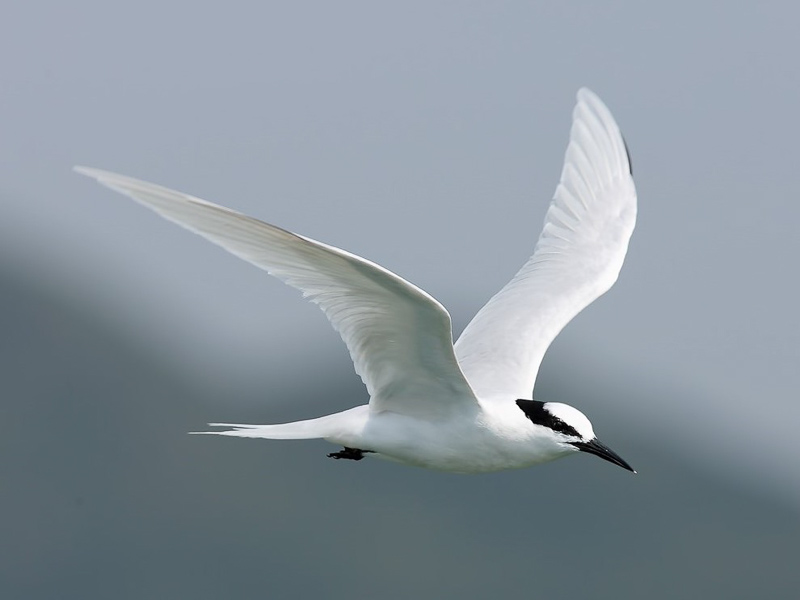Black-naped Tern Sterna sumatrana 黑枕燕鷗
Category I. Locally common summer visitor usually seen at breeding islets in eastern waters, but also on migration.
IDENTIFICATION

Jul. 2008, Michelle and Peter Wong. Adults.
33-35 cm. The palest and smallest of the terns breeding in HK. Distinctive black mask beginning at point on lores and broadening to cover the hind neck. Bill and legs black.

Jul. 2008, Michelle and Peter Wong. Adult.
Upperparts very pale grey apart from blackish outer web of outermost primary. Underwings and underbody white.

Aug. 2021, Martin Hale. Juvenile.
Juveniles have mottled greyish crown to hind neck and poorly-defined short blackish mask from mid lores to behind eye. Mantle, scapulars, median and inner greater coverts and tertials have diffuse greyish fringe around tips of feathers. Heavily marked birds may be difficult to separate from juvenile Roseate Tern but differ from the latter in having crown paler than mask and hind neck, paler mantle and scapulars due to narrower dark fringes, extensive paler areas in tertials and broader more diffuse pale edge to inner webs of primaries (visible at rest).

Jul. 2008, Michelle and Peter Wong. Juveniles.
Older juveniles show the overall paleness of adults contrasting with the dark markings of immaturity.
VOCALISATIONS
Generally, vocalisations are higher in pitch than those of Roseate Tern and more likely to be monosyllabic.
Juvenile calls are similar to other Sterna terns.
DISTRIBUTION & HABITAT PREFERENCE
Generally seen at or near the rocky islet breeding colonies in the summer, though also in inshore waters on passage, foraging or as storm-blown waifs.
OCCURRENCE
The first acceptable report is now considered to be that of one at Ting Kau on 2 August 1979 during the passage of Typhoon Hope. Occasional sightings in the next few years culminated in the discovery of a small breeding colony at Kung Chau in Mirs Bay in July 1983, when Black-naped Tern became the first seabird recorded breeding in HK (Axell 1984).
Black-naped Tern is a summer visitor that breeds on isolated rocky islets off the south and east coasts. The earliest birds arrive abruptly in the second half of April, though the earliest record occurred on 4 April 2000. By the end of April the breeding colonies are occupied and birds are then present throughout the summer, dispersing from late August onwards. By mid-September birds have usually departed HK waters, and after this date only the occasional storm-blown bird at sea-watching localities such as Cape D’Aguilar and Cheung Chau is recorded. The latest record is that of three birds in Long Harbour on 16 October 1983, while the latest since 1999 concerned one at Mai Po NR, the first Deep Bay record, on 25 September 2011.
During the 1970s Black-naped Tern was not observed on offshore islands during the summer (D.S. Melville pers. obs.). It has been suggested that the establishment of a substantial breeding population may in part be attributable to a decline in the numbers of larger, predatory fish in HK waters because of over-fishing (K. Wilson pers. comm.). This in turn has allowed numbers of smaller fish to increase, to the benefit of terns such as Black-naped and Roseate.
BEHAVIOUR, FORAGING & DIET
Recorded taking small fish from the sea, but no details.
BREEDING
Since 2011 annual surveys have been carried out of the breeding population of breeding terns in HK. Surveys are made from moving boats that are often unable to make a close approach due to sea conditions, which makes it difficult to collect accurate data on the number of pairs or juveniles on or near the nest. From 2011 to 2021 the peak annual count of birds at breeding colonies varied from 281 to 595 (mean 399) (AFCD in litt.). The nesting period, which lasts from the first week of May to the first week of September, is longer than that of other breeding terns in HK.
RANGE & SYSTEMATICS
Breeds in sea areas off south China to southern Japan, the Gulf of Thailand, eastern areas of the Bay of Bengal, from northern Philippines south to Sumatra, and in the western Pacific from New Guinea east; winters at sea in nearby areas except the South China Sea (Gochfeld et al. 2020). In China a summer visitor to the East and South China Seas (Liu and Chen 2020).
The nominate subspecies breeds in the east Indian and west Pacific Oceans, including HK, while S. s. mathewsi breeds in the west Indian Ocean.
CONSERVATION STATUS
IUCN: Least Concern. Population trend unknown.
Axell, B. (1984). New for Hong Kong. British Birds 77: 168.
Gochfeld, M., J. Burger, and E. F. J. Garcia (2020). Black-naped Tern (Sterna sumatrana), version 1.0. In Birds of the World (J. del Hoyo, A. Elliott, J. Sargatal, D. A. Christie, and E. de Juana, Editors). Cornell Lab of Ornithology, Ithaca, NY, USA. https://doi.org/10.2173/bow.blnter1.01
Liu, Y. and Y. H. Chen (eds) (2020). The CNG Field Guide to the Birds of China (in Chinese). Hunan Science and Technology Publication House, Changsha.

